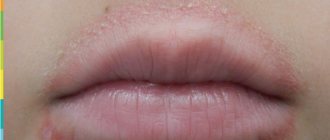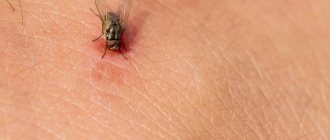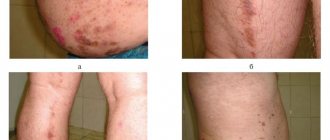Allergies to cosmetics are quite common. Most often, the mucous membranes of the eyes, eyelids, facial skin and décolleté area suffer from an allergic reaction. There are several reasons for allergies to cosmetics. At the same time, the body’s reaction to the use of cosmetics can manifest itself in completely different ways. The most common intolerance to individual components of decorative cosmetics, creams, masks and lotions.
Why allergies occur
Allergy as an essence is an overactive reaction of the body to the effects of allergens
: substances that provoke an undesirable skin reaction. A person is a complex, individual organism, which means that the causes of allergies can be different. Most often, the tendency to certain reactions is due to a whole complex of different factors. These include:
- genetic predisposition;
- hormonal levels, the presence of chronic diseases, vitamin deficiency, decreased immunity during therapy;
- stress, climate change, neglect of protection from UV radiation;
- increased sweating and skin sensitivity.
These factors create an environment for the development of dermatitis -
skin reactions to contact with a certain irritant. In this case, both household chemicals and animals, perfumes, fabrics, flowers, medicines or food can act as an allergen.
Alas, even ordinary nuts can make you sneeze and itch, just like cleansing foam, and even your furry pet. This does not mean that you need to avoid everything around you and live in a hypoallergenic spacesuit. But it’s worth drawing conclusions and becoming more attentive to the world around you and the products you consume.
One of the possible tests for allergies is skin testing. The test is performed by an allergist
Read also
Food allergies
What is the difference between food allergy and food intolerance? Food allergy is the response of the immune system to the intake of a particular food that causes an allergic reaction.
Even a small amount of associated... Read more
Allergic bronchial asthma
What is allergic bronchial asthma Bronchial asthma is a fairly common chronic disease, which in most cases is allergic in origin.…
More details
Allergic conjunctivitis
What is allergic conjunctivitis With prolonged exposure of the human body to allergens, such as pollen, yeast spores, eye symptoms associated with inflammation may appear.…
More details
The concept of secondary immune deficiency
The concept of secondary immune deficiency Immunodeficiency disorders can be congenital or acquired. A congenital or primary disorder is something that a person is already born with. Purchased...
More details
Pollen allergy
What is a pollen allergy? Pollen is a fine mist produced by trees, flowers, grasses and weeds for the purpose of reproduction. Many people have an unfavorable immune response...
More details
How to recognize allergies to cosmetics
In terms of external manifestations, an allergy to cosmetics may not differ from an allergy to a new coat or perfume. However, there is a difference. Lipstick, cream or mask is applied locally, which means a reaction will occur in this area. You should be alert to symptoms such as:
- local moderate redness at the site of application;
- mild itching and burning;
- dryness, cracks and peeling;
- local tissue swelling.
These symptoms are referred to as simple contact dermatitis.
. The reaction may appear after one application and will disappear as soon as you eliminate the cause of the irritation.
Allergic dermatitis is also distinguished
. It manifests itself in the form of severe itching, rash, bright redness and weeping rashes. It can last a long time and spread to areas of the skin that have not been in contact with cosmetics.
Another type of dermatitis is photoallergic
. It is expressed in the form of rashes on open areas of the skin not protected by clothing, redness and itching. Occurs due to skin sensitivity to the sun (photosensitization) after the use of retinoids, polyunsaturated fatty acids, natural essential oils, para-aminobenzoic (PABA or vitamin B10) and salicylic acids.
Remember: only a doctor can correctly determine the type of irritation, make a diagnosis and select an effective treatment regimen!
Features of contact cosmetic dermatitis
It’s hard to imagine a modern apartment without a bathroom and a dressing table with cosmetics. However, the skin does not always tolerate what a woman wants to please herself with. Sometimes it happens that the use of cosmetics causes cosmetic dermatitis. This in turn can cause irritant contact dermatitis, allergic contact dermatitis, photosensitivity and photoallergy, contact urticaria and pigmentation disorders.
The skin is quite resilient, it can generally cope with unnecessary irritants, but there is a limit to everything. Each organism has its own threshold of sensitivity. If it is exceeded, intolerance to some factor appears, for example, a cosmetic product or a separate ingredient of cosmetics.
The problem can occur even if there is little of it, but cosmetics are applied to the skin often. As a result, contact eczema appears. It is clinically difficult to distinguish allergic contact eczema from non-allergic (irritant) eczema.
Lotions, creams and perfumes often cause allergies, as they remain on the skin for a long time. Short-term use cosmetics rarely cause contact reactions.
Natural cosmetics = safe cosmetics?
Serum with a high content of vitamin C, tonic with essential oils and lemon, sea buckthorn cream. And no “chemistry”! Sounds tempting. True, this does not mean at all that an allergic reaction will not occur to these extremely “natural”, environmentally friendly products.
This may surprise you, but the most hypoallergenic products are synthetic, since they do not contain proteins that are primarily perceived by the immune system as foreign to the body and requiring immediate destruction. If you pay attention to children's cosmetics from serious large companies, the number one component there will be mineral oil. And not because “they want to destroy children” and “bathe them in oil,” but because this is the safest component that will not cause, for example, Quincke’s edema.
Delicate skin – sensitive skin
In dermatology, there is a term “sensitive skin”, which refers to the sum of subjective and objective sensations. Sensitive skin is characterized by increased neurosensory sensitivity and an overreaction of the immune system.
In Europe, 1/3 of children born suffer from allergies; this is a genetically determined disease. It is predicted that in 2022 the number of allergy sufferers will exceed the number of healthy people. In addition to genetic sensitivity, there is also acquired sensitivity, depending on the degree of damage to the epidermal barrier by environmental factors.
Delicate skin – sensitive skin
Allergens in cosmetics according to European standards
In January 2007, the European Scientific Committee for Consumer Safety (SCCS) approved a special “List 26”. It included 26 substances that most often cause allergies in cosmetics, which, however, can be added to cosmetics, subject to mandatory inclusion on the label. Components from “List 26” are divided into two sections depending on the frequency of allergic reactions.
LIST A
“List A” includes components with a very high frequency of allergic reactions and with a large number of documented evidence.
- Amyl cinnamal is
a synthetic fragrance.
Amylcinnamyl alcohol
is a synthetic fragrance.
Benzyl alcohol
is a component of essential oils of jasmine, hyacinth, and ylang-ylang.
Benzyl salicylate
is a component of many essential oils.
Cinnamyl alcohol
is a component of cinnamon leaf essential oil, as well as Peruvian balsam and styrax.
Cinnamal
is a component of cinnamon bark essential oil.
Citral
is a component of many essential oils with a pronounced lemon sound (from lemon itself to verbena).
Coumarin
is a component of tonka bean essential oil.
Eugenol
is a component of essential oils of bay, cloves, cinnamon, basil, and nutmeg.
Geraniol
is a component of rose, palmarosa, and citronella essential oils.
Hydroxycitronellal
is a synthetic fragrance.
Hydroxymethylpentyl-cyclohexenecarboxaldehyde
is a synthetic fragrance.
Isoeugenol
is a component of ylang-ylang essential oil.
LIST B
“List B” includes components with lower frequency and less documented evidence.
- Anisyl alcohol
is a synthetic fragrance.
Benzyl benzoate is
a component of essential oils of tuberose, hyacinth, as well as Peruvian, Tolu and Copai balsams.
Benzyl cinnamate
is a component of Peruvian, Tolu and Copai balsams.
Citronellol is
a component of rose, geranium, and citronella essential oils.
Farnesol
is a component of many essential oils (from lemongrass to neroli).
Hexyl cinnamaldehyde
is a component of chamomile essential oil.
Lilial is
a synthetic fragrance.
d-Limonene is
one of the main components of citrus essential oils.
Linalool
is a component of many essential oils and is found in 200 types of plants from lavender to cinnamon.
Methyl heptine carbonate
is a synthetic fragrance.
Alpha-Isomethyl Ionone
is a synthetic fragrance.
Oak moss
- oak moss.
Tree moss
is the collective name for mosses.
Proper care for sensitive skin
Cosmetics for sensitive skin are subject to strict evaluation. Tests are carried out in dermatological clinics on a group of people strictly with this skin type.
Patients with sensitive skin should use products from the same series, where the number of ingredients is limited. The main task is to restore the epidermal barrier. The composition of the products should include substances that compensate for defects in the hydrolipid chain, for example, vegetable oils, butters, waxes, which create an occlusive film on the skin. Moisturizing substances that act both on the surface and deep in the skin are important.
Restoring the epidermal barrier
Facial cleansing should be done carefully and with appropriate measures. It is good to use gentle cleansing cosmetics that will not disturb the natural surface of the skin. Avoid medications containing alcohol.
Is it possible to prevent allergies?
A few rules to help you protect yourself:
- Study the ingredients of the products before purchasing.
The most common triggers for rashes and itching are natural fragrances (essential oils), some preservatives, dyes (mainly found in pigments in decorative cosmetics and hair dyes), honey and its derivatives. Rarely: mineral oils, plant extracts, minerals, lanolin. This doesn't mean you should avoid these remedies, but it's best to be on the lookout. Especially with severe skin sensitivity. - Test new cosmetics before use.
To do this, apply a little product to the crook of your elbow and wait up to 48 hours. - Follow the rules for storing products
and do not use cosmetics after the expiration date. - Always follow the manufacturer's recommendations.
Do not overexpose masks, do not apply creams to the mucous membranes, and do not use products intended for professionals without the appropriate skills.
Cosmetic risks. Ingredients that cause cosmetic allergies
Cosmetics ingredients most commonly associated with contact eczema include:
- Flavors. Several thousand fragrance substances are known, and each of them is a potential contact allergen. Therefore, for sensitive skin it is best to use fragrance-free products.
- Preservatives. Significantly enhance the inflammatory response when used on damaged skin. Irritants include, for example, formaldehyde and the formaldehyde donors, isothiazolinones.
- Cosmetic basics. Rarely cause allergies. Allergens include propylene glycol, lanolin, eucerin.
- Plant extracts. May cause photoallergic reactions. Strong allergens, such as St. John's wort and citrus extracts.
Ingredients that Cause Cosmetic Allergies
Damage to the epidermal barrier is often caused by popular cleansers, as well as highly exfoliating ingredients and dyes. Sensitivity can result from allergies to several cosmetic ingredients. They can mutually enhance allergenic properties and create allergenic compounds.
What to do if your skin reacts to cosmetics
If any component of cosmetics does cause an undesirable skin reaction in you, then the first thing to do is stop using this product and wash it off your skin
. After this, you should check the instructions and check the expiration dates. If you did everything correctly and the cosmetics are not expired, act according to the situation:
- Watch the dynamics. If the reaction begins to subside within an hour, it is enough not to use the product anymore.
- Take your usual antihistamine (Suprastin, Fenistil, etc.)
- If symptoms persist, consult your doctor
.
What to do next?
The first desire after purchasing unsuitable cosmetics is to return it to the store and receive compensation from the manufacturer. However, according to the consumer protection law, cosmetics are included in the list of products that cannot be returned or exchanged
(see Decree of the Government of the Russian Federation dated January 19, 1998 No. 55
“On approval of the Rules for the sale of certain types of goods...”
). You can get your money back only in one case: if the cosmetics you bought turned out to be of poor quality. Keep in mind: an individual allergic reaction does not prove that the product is defective.
Therefore, it is better to offer the remedy to someone else, explaining the situation honestly. Place ads on special services, in thematic groups on social networks, or share an unsuitable product with family or friends.
As for further purchases, do not rush to give up shopping! If a rash occurs with one cream, this does not mean that the same reaction will occur with another. Try to establish which component triggered the allergy.
. An allergist can help with this by prescribing the necessary tests. In the future, just avoid products containing this ingredient.
Capricious and complex - what is the difference between sensitive skin and allergic skin?
Such skin does not tolerate factors that do not irritate others. Sensitivity is an individual trait that has different causes and manifestations. Symptoms vary by age and area of the body. Children have sensitive skin all over their body. In adults, this is most often the face, the delicate area around the eyes, neck and décolleté. Hands are also often susceptible to allergies, as they come into more contact with irritating factors, such as household chemicals.
Skin sensitivity can be the result of illness, hormonal imbalance, stress, or it can develop as a result of sunburn. People with dry and very dry skin also become sensitive to cosmetics because their skin has weaker secretion of the sebaceous glands responsible for creating a protective layer.
However, it is worth remembering that sensitive skin is not the same as skin prone to allergies. Despite the fact that contact with an allergen causes similar reactions in both skin types, they appear at different times.
- If they appear immediately after using a cosmetic product, we are dealing with sensitive skin.
- If a reaction occurs after a few hours, we talk about an allergy.
Often one skin type is replaced by another, and sensitive skin becomes susceptible to allergens over time.
How we take care of our clients
pays close attention to cosmetic ingredients. We use components from trusted laboratories that have the necessary safety and quality certificates. Before release, our products are tested in laboratories. For your convenience, we place detailed information about the composition and features of the use of our products on the packaging and in product cards in the official online store aravia.ru.
In case of an undesirable skin reaction to the product, we ask you to send us an email
- photos of skin reactions;
- photographs of the product so that the batch number is visible;
- a detailed story about exactly how you used the product;
- additional contacts for prompt communication.
We will then be able to help you and determine the possible cause of the reaction, and decide as quickly as possible how to proceed.
The skin barrier - what is the danger of damaging it?
Sensitive skin has a damaged protective physical barrier, which allows unfriendly dust particles, toxins, allergens, microorganisms and cosmetic ingredients to penetrate the skin.
The immune resistance of damaged skin is significantly reduced. Inflammatory mediators trigger the inflammatory response. From a dermatological point of view, this is an asymptomatic period - the skin reacts sharply, but without visible manifestations.
After some time, dry skin, erythema, rashes and telangiectasia appear. This is the symptomatic period of sensitive skin disease.
Paradoxically, barrier damage is caused by too frequent use of aggressive cosmetics, as well as improper care, when cosmetics are used too sparingly or not at all for fear of irritation.
Don't get too carried away!
By the way, don’t forget that being too fanatical about cleaning is also bad. It only fills the room with toxic and irritating substances. For example, antibacterial agents are good for the toilet, but only if everyone in the house is healthy. They are absolutely not needed to clean the floors in a children's room or living room. In everything (including cleaning) you need to observe moderation.
Paying attention to your health and responsibly following your doctor’s recommendations will soon help you overcome the unpleasant symptoms of an allergy to household chemicals.
A modern type of cosmetics – neurocosmetics
Under the influence of an irritating substance, the skin is strongly innervated, and nerve fibers synthesize and release molecules called neuropeptides. A cascade of reactions is triggered, leading to neurogenic inflammation with dilation of blood vessels and an increase in their permeability. As a result, the skin turns red. These changes may be accompanied by swelling, heat, tingling or itching.
A modern type of cosmetics – neurocosmetics – works at the level of skin nerve cells. In addition to traditional soothing ingredients such as chamomile, panthenol, allantoin, aloe, witch hazel, and algae extracts, they contain ingredients that block inflammatory mediator irritants.
Blockers modify immune responses at the skin level, trap and eliminate neurotransmitters of the inflammatory process. Symptoms of irritation decrease or do not appear at all. This is a big step in cosmetology!











